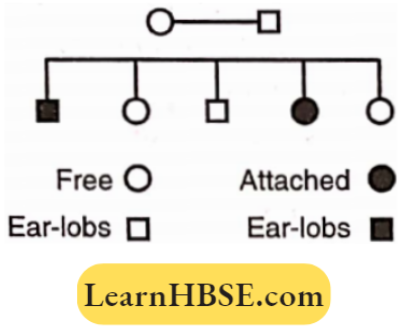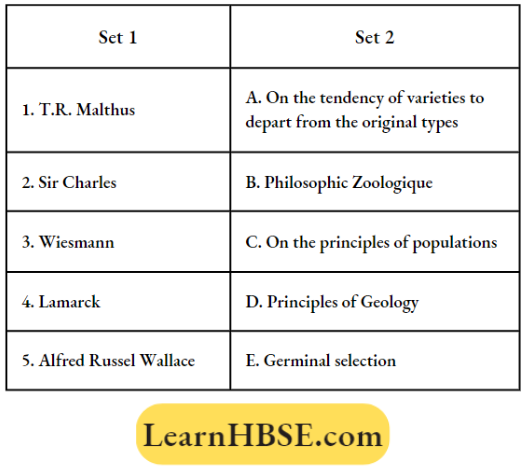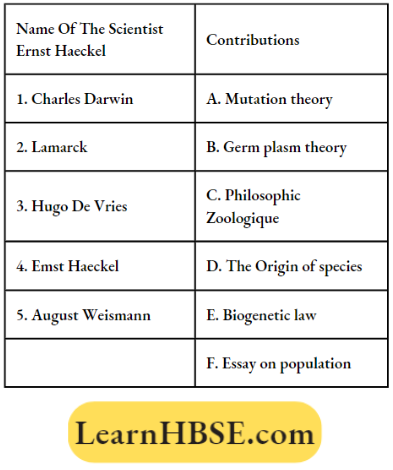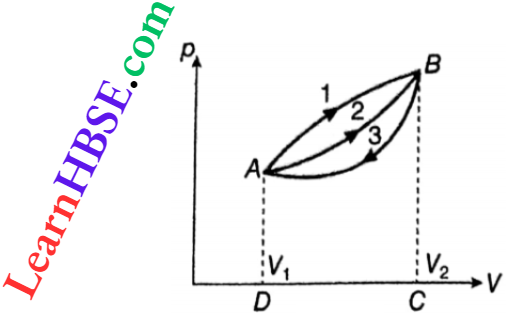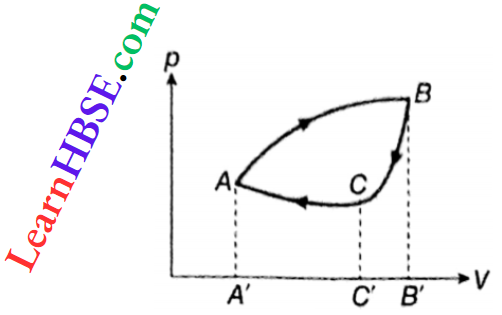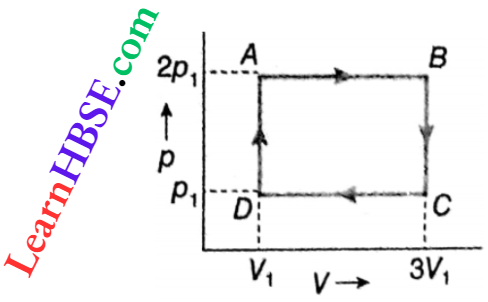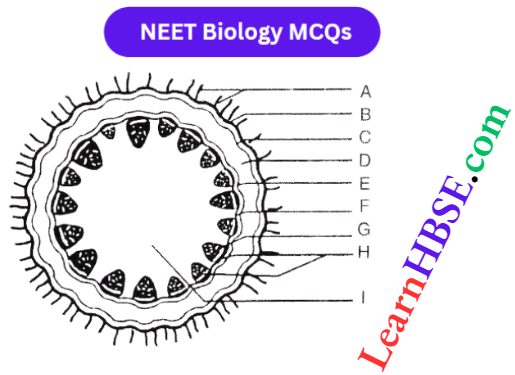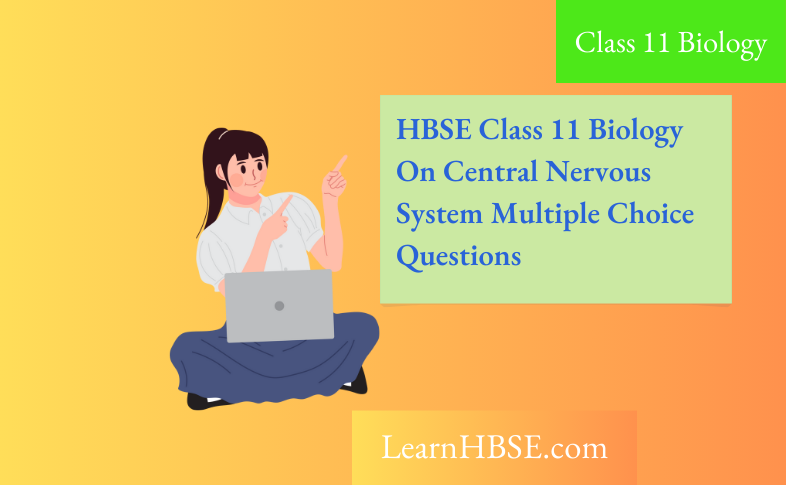Question 1. Which animals dominated in the Palaeozoic era?
- Fish
- Birds
- Reptiles
- Mammals.
Answer: 1. Fish
Question 2. Which is supposed to be the largest known fossils of reptiles?
- Stegosaurus
- Diplodocus
- Gigantosaurus
- Igamanodon.
Answer: 4. Igamanodon.
Question 3. Analogous organs have a:
- Common embryonic origin but performs different functions
- Different embryonic origins and perform different functions
- Different embryonic origins but perform similar functions
- Common embryonic origin and perform similar functions.
Answer: 3. Different embryonic origin but perform similar functions
evolution mcq
Question 4. Birds evolved from:
- Reptiles
- Amphibians
- Fishes
- Tetrapods.
Answer: 1. Reptiles
Question 5. Possession of venoms in animals is an attribute to:
- Fossorial adaptation
- Desert adaptation
- Arboreal adaptation
- Aquatic adaptation.
Answer: 2. Desert adaptation
Evidence Of Evolution Class 12 HBSE Notes
Question 6. First mammals occurred in which era period?
- Permian-Palaeozoic
- Triassic-Mesozoic
- Tertiary-Cenozoic
- None of these.
Answer: 2. Triassic-Mesozoic
Question 7. The appearance of ancestral characters in the newborns, such as the tail, multiple mammae etc. is known as:
- Homologous
- Analogous
- Atavism
- Vestigial.
Answer: 3. Atavism
Question 8. The correct sequence is:
- Palaeozoic —Mesozoic—Cenozoic
- Mesozoic—Archaeozoic—Proterozoic
- Palaeozoic—Archaeozoic—Coenozoic
- Archaeozoic—Palaeozoic—Coenozoic.
Answer: 1. Palaeozoic —Mesozoic—Cenozoic
Question 9. A bird with teeth is:
- Kiwi
- Ostrich/King Vulture
- Dodo
- Archaeopteryx.
Answer: 4. Archaeopteryx.
Fossil Evidence Of Evolution Examples Class 12 Biology
Question 10. The recapitulation of protozoan ancestry is seen in:
- Poriferan zygote
- Colonies of hydrozoa
- Zygote of metazoans
- Anthozoa.
Answer: 3. Zygote of metazoans
Question 11. The term used for similarity in organ structure seen in great diversity is:
- Homology
- Analogy
- Symmetrical
- Identical.
Answer: 1. Homology
evolution class 12 mcq
Question 12. Homologous organs are those that show similarities in
- Origin
- Size
- Appearance
- Function.
Answer: 1. Origin
Question 13. Which of the following is a connecting link?
- Limulus
- Peripatus
- Periplaneta
- Pila.
Answer: 2. Peripatus
Comparative Anatomy As Evidence Of Evolution Class 12
Question 14. Which set includes all vestigial structures of man?
- Vermiform appendix, body hair and cochlea
- Coccyx, appendix, ear muscles
- Coccyx, wisdom tooth, patella
- Ear muscles, atlas, body hair.
Answer: 2. Coccyx, appendix, ear muscles
Question 15. Mesozoic era is the era of:
- Fishes
- Reptiles
- Birds
- Mammals.
Answer: 2. Reptiles
Question 16. The most evident source of evolution is:
- Fossils
- Embryos
- Morphology
- Vestigial organs.
Answer: 1. Fossils
Question 17. A scene from the Jurassic period: Dinosaurs roaming in carboniferous forests, eating plants, killing each other and being eaten by lions and tigers. What is the catch?
- There were no carboniferous forests when dinosaurs were there
- All dinosaurs were carnivorous
- Lions and tigers had not evolved by that time
- Dinosaurs did not fight among themselves.
Answer: 3. Lions and tigers had not evolved by that time
Question 18. Free caudal vertebrae occurred in fossil Archaeopteryx. The trait is:
- Reptilian
- Avian
- Neither 1 nor 2
- Mammalian.
Answer: 1. Reptilian
questions about evolution
Question 19. Gondwana Land comprised:
- India and Australia
- India. Australia and New Zealand
- India, Australia, New Zealand and South Africa.
- India, Australia, New Zealand, South Africa and South America.
Answer: 4. India, Australia, New Zealand, South Africa and South America.
Question 20. The origin of different finches on the Galapagos islands is an example of:
- Convergent evolution
- Divergent evolution
- Adaptive radiation
- Both 2 and 3.
Answer: 4. Both 2 and 3.
Embryological Evidence Of Evolution Class 12 HBSE
Question 21. Related species of Alligators and Magnolias occur in:
- Both sides of the isthmus of Panama
- China and Japan
- China and eastern U.S.A,
- Parts of Russia and Canada.
Answer: 3. China and eastern U.S.A,
Question 22. Neoceratodus is a connecting link between
- Cyclostomes and fishes
- Fishes and amphibians
- Amphibians and reptiles
- None of the above.
Answer: 2. Fishes and amphibians
Question 23. Which of the following are connecting links?
- Lung fishes
- Prototherians
- Peripatus
- All of the above.
Answer: 4. All of the above.
Question 24. Tachyglossus is a connecting link between:
- Reptiles and birds
- Reptiles and mammals
- Birds and mammals
- All the above.
Answer: 2. Reptiles and mammals
Question 25. Why do we dig fossils and study them?
- To find new fossils that have not yet been recorded
- Fossil finding gives occupation to scientists
- Fossil fills the gaps in the evolutionary records of animals
- Fossils throw light on the evolution of animals of the past.
Answer: 4. Fossils throw light on the evolution of animals of the past.
Molecular Evidence Supporting Evolution Class 12 Biology
Question 26. Which one of the following is used for dating archaeological specimens in wood, bones and shells?
- Uranium – 238
- Argon Isotope
- Carbon – 14
- Strontium – 90.
Answer: 3. Carbon – 14
Question 27. Physiological evidence in favour of evolution is demonstrated by:
- Similarity in body structures
- Closely related forms being placed in the same group of animals
- Identity in the functioning of hormones and chemical- physiological nature of blood
- None of the above.
Answer: 3. Identity in the functioning of hormones and chemical- physiological nature of blood
Question 28. Being all mammals,, dolphins, bats, monkeys and horses have some important common characteristics but they also show the conspicuous differences. This is due to the phenomenon of:
- Genetic drift
- Convergence
- Divergence
- Normalization.
Answer: 3. Divergence
Question 29. The Lederberg Replica-Plating experiment has proved in evolution, the role of:
- Natural selection
- Artificial selection
- Adaptation in evolution
- All the above.
Answer: 4. All the above.
Biogeographical Evidence For Evolution Class 12 HBSE
Question 30. Pliohippus arose in:
- Holocene
- Pliocene
- Oligocene
- Miocene.
Answer: 2. Pliocene
Question 31. Amphibia first appeared in:
- Permian
- Carboniferous
- Devonian
- Silurian.
Answer: 3. Devonian
Question 32. The Permian period during which the first most modern orders of insects appeared, occurred approximately:
- 80 million years ago
- 150 million years ago
- 280 million years ago
- 550 million years ago.
Answer: 3. 280 million years ago
Question 33. Dinosaurs were abundant in:
- Jurassic period
- Devonian period
- Permian period
- Pleistocene period.
Answer: 1. Jurassic period
Question 34. Which of the following statements is wrong?
- Continuous variations appear suddenly or accidentally
- Continuous variations are very common and they are caused due to environmental changes
- Both (1) and (2)
- None of the above.
Answer: 3. Both (1) and (2)
Question 35. Some insects, such as cockroaches have biting and chewing mouth parts, housefly has sponging type of mouth parts, whereas a mosquito has piercing and sucking mouth parts. These various types of mouth parts are examples of:
- Analogous organs
- Homologous organs
- Similar organs
- Dissimilar organs.
Answer: 2. Homologous organs
evolution means fill in the blanks
Question 36. According to the geologic time-table, man belongs to:
- The Pleistocene epoch of the quaternary period of Coenozoic era
- Cretaceous period of Mesozoic era
- Permian period of Palaeozoic era
- Oligocene epoch of tertiary period of Cenozoic era.
Answer: 1. Pleistocene epoch of the quaternary period of Coenozoic era
Question 37. For how many years have the dinosaurs been extinct?
- About 65 million years
- About 135 m. years
- About 230 m. years
- About 280 m. years.
Answer: 1. About 65 million years
Types Of Evidence Of Evolution Class 12 Biology
Question 38. When did the first forest appear?
- In the Cambrian period of Palaeozoic era
- In Devonian period of Palaeozoic era
- In Jurassic period of Mesozoic era
- In the tertiary period of the Coenozoic era.
Answer: 2. In Devonian period of Palaeozoic era
Question 39. The word ‘Dinosaur’ was invented by
- G. Gaylord Simpson
- Sir Richard Owen
- J.L.B. Smith
- Empedocles.
Answer: 2. Sir Richard Owen
Question 40. Which one of the following fossils represents a connecting, link between the evolution of mammals from reptiles?
- Archaeopteryx
- Sphenodon
- Mammoth
- Dimetrodon.
Answer: 4. Dimetroden.
Question 41. Birbal Sahni Institute of Palaeobotany is located at:
- Lucknow
- Kolkatta
- Pune
- Bangalore.
Answer: 1. Lucknow
Question 42. Monera evolved during:
- Azoic
- Archaeozoic
- Proterozoic
- Precambrian.
Answer: 2. Archaeozoic
Question 43. Age of trilobites is:
- Precambrian
- Devonian
- Cambrian
- Permian.
Answer: 3. Cambrian
Artificial Selection As Evidence Of Evolution Class 12
Question 44. The epoch in which the first man-like creatures evolved was:
- Holocene
- Pliocene
- Pleistocene
- Miocene.
Answer: 2. Pliocene
Question 45. What are the fossil contents of alimentary canals known as?
- Trails
- Casts
- Coprolite
- Impressions.
Answer: 3. Coprolite
Question 46. During fossilisation soft parts decompose and harder parts are impregnated with minerals and turn into stony shapes and are called:
- Moulds
- Casts
- Petrified
- Coprolites.
Answer: 3. Petrified
Question 47. The origin of the first mammals occurred:
- 220 million years ago
- 600 million years ago
- 240 million years ago
- Over 1600 million years ago.
Answer: 3. 240 million years ago
Question 48. The term orthogenesis means:
- Indirect evolution
- Evolution in a straight line
- Species differentiation
- Change in germplasm.
Answer: 2. Evolution in a straight line
Question 49. The term orthogenesis was proposed by:
- Haeckel
- Cuvier
- Darwin
- Julian Huxley.
Answer: 1. Haeckel
Question 50. The oldest fossils of land animals consist of:
- Amphibians
- Centipedes
- Primitive spider
- Both 2 and 3
Answer: 1. Amphibians
Question 51. Placental wolf and Tasmanian wolf, marsupial exhibit:
- Adaptive radiation
- Convengent evolution
- Divergent evolution
- Homology
Answer: 2. Convengent evolution
Question 52. The age of mammals and birds is known as:
- Palaeozoic
- Cenozoic
- Mesozoic
- Proterozoic.
Answer: 2. Coenozoic
Question 53. Which of the following were the dominant animals of Palaeozoic era?
- Birds
- Egg laying mammals
- Reptiles
- Cartilage and bony fishes.
Answer: 4. Cartilage and bony fishes
Question 54. The founder of modem palaeontology is:
- Birbal Sahni
- Steward
- Cuvier
- Leonard de Vinci.
Answer: 3. Cuvier
Question 55. Remains of woolly Mammoth found in the permafrost of Siberia are:
- 5000 years old
- 25000 years old
- 500,000 years old
- 2.5 million years old.
Answer: 2. 25000 years old
Question 56. Pompeii city was buried in lava of Mount Vesuvius during:
- 635 B. C.
- 79 A. D.
- 635 A. D.
- 1379 A. D.
Answer: 2. 79 A. D.
Question 57. Compressions are a type of fossils having:
- All internal details
- Organic material is replaced by mineral matter
- Compressed remains of dead organisms
- Thin carbon film showing external features.
Answer: 4. Thin carbon film showing external features.
Question 58. Fossils of Archaeopteryx were found from:
- Jurassic rocks
- Triassic rocks
- Cretaceous rocks
- Cenozoic rocks.
Answer: 1. Jurassic rocks
Question 59. Birds are glorified reptiles has been proved by the discovery of fossils which resembles birds and reptiles:
- Struthio
- Archaeopteryx
- Apteryx
- Ornithorhynchus.
Answer: 2. Archaeopteryx
Vestigial Organs As Proof Of Evolution Class 12 HBSE
Question 60. What is the appearance of ancestral characters in an individual called?
- Atavism
- Analogy
- Homology
- None of the above.
Answer: 1. Atavism
Question 61. Proteus engines is characterised by vestigial:
- Limbs
- Eyes
- Wings
- Vermiform appendix.
Answer: 2. Eyes
Question 62. The flightless bird of Australia is:
- Kiwi and Rhea
- Rhea and Emu
- Emu and Cassowary
- Emu and Kiwi.
Answer: 3. Emu and Cassowary
Question 63. An incompletely three-chambered heart occurs in:
- Protopterus
- Chiamera
- Salamander
- Dogfish.
Answer: 1. Protopterus
Question 64. Sacculina shows:
- Retrogressive metamorphosis
- A number of vestigial organs
- Progressive metamorphosis
- Protochordate traits.
Answer: 1. Retrogressive metamorphosis
Question 65. Who proposed for the first time that a developing animal embryo passes through stages resembling adults of its ancestors:
- Von Baer
- Meckel
- Haeckel
- Darwin.
Answer: 2. Meckel
Question 66. Replacement of original hard parts or even the soft tissues of the organisms by minerals is known as:
- Compression
- Petrification
- Moulds
- Amber.
Answer: 2. Petrification
Question 67. Stings develop from:
- The last abdominal segment in Honey Bee and Scorpion.
- Ovipositor in Honey Bee and scorpion
- Ovipositor in Honey Bee and last abdominal segment in Scorpion.
- The last abdominal segment in Honey Bee and ovipositor in Scorpion.
Answer: 3. Ovipositor in Honey Bee and last abdominal segment in Scorpion
Question 68. Cycas and Ginkgo are connecting links between:
- Bryophytes and pteridophytes
- Pteridophytes and gymnosperms
- Gymnosperms and angiosperms
- Thallophyta and bryophyta.
Answer: 2. Pteridophytes and gymnosperms
Question 69. Which one of the following animals has been extinct recently?
- Dodo
- Dinosaur
- Pterodactyl
- Mammoth.
Answer: 1. Dodo
Examples Of Homologous And Analogous Organs Class 12
Question 70. Analogous organs with similar external morphology are called:
- Heteroplastic
- Homoplastic
- Heteromorphic
- Both 2 and 3
Answer: 2. Homplastic
Question 71. Possession of accessory respiratory organ in Anabas is an example of:
- Ecological adaptations
- Physiological adaptations
- Parasitic adaptations
- None of the above.
Answer: 1. Ecological adaptations
Question 72. How did dinosaurs become extinct? There are many hypotheses. One mostly accepted is:
- Due to sudden changes in the environment
- Due to global warming
- Due to the impact of meteorites
- Due to their predation by lions and tigers.
Answer: 3. Due to the impact of meteorites
Question 73. Find the odd man out:
- Seal’s flipper
- Bat’s wing
- Horse’s foot
- Butterfly’s wings.
Answer: 4. Butterfly’s wings.
Question 74. The biggest and heaviest dinosaur was:
- Brachiosaurus
- Tyrannosaurus
- Allosaurus
- Stegosaurus.
Answer: 1. Brachiosaurus
Question 75. The first fossil bird found in the rocks of the Jurassic period belongs to genera:
- Archaeopteryx
- Archaeomis
- Both (1) and (2)
- None of the above.
Answer: 3. Both (1) and (2)
Question 76. In Birbal Sahni Institute of Palaeobotany in Lucknow, 3.2 billion-year-old rocks are kept which have fossils of:
- Algae
- Euglena
- Virus
- Cyanobacteria.
Answer: 4. Cyanobacteria.
Question 77. The flowering plants originated in:
- Cretaceous
- Tertiary period
- Triassic
- Carboniferous.
Answer: 3. Triassic
Question 78. The study of the fossil plants is known as:
- Palaeontology
- Palaeobotany
- Palynology
- Palaeoanatomy.
Answer: 2. Palaeobotany
Question 79. Point out the correct statement regarding the evolution of the horse.
- The premolars and molars increased in length while their roots became short
- The brain became smaller
- Ankles became low
- None of the above.
Answer: 1. The premolars and molars increased in length while their roots became short
Question 80. What is the recent example of the mass extinction of organisms?
- Cycadofilicales
- Dinosaurs
- Tree ferns
- Neanderthal man.
Answer: 4. Neanderthal man.
Question 81. Plants which are naturally fast disappearing from the scene are:
- Cycads and Ginkgos
- Tulips and Magnolias
- Bombaxi and Bamboos
- Rhododendrons and Rhizophores.
Answer: 1. Cycads and Ginkgos
Question 82. Find the odd man out:
- The trunk of an elephant and the hand of a chimpanzee
- Ginger and potato
- Wings of bat and bird
- Nails of human beings and claws of a cat.
Answer: 1. Trunk of an elephant and the hand of a chimpanzee
Question 83. Which of the following rules states that organisms have a tendency towards increase in size during their evolution?
- Williston’s rule
- Cope’s rule
- Dollo’s rule
- Hardy-Weinberg’s rule.
Answer: 2. Cope’s rule
Question 84. Different groups of plants (and also animals) have similar proteins. What is the type of evidence?
- Physiological
- Cytological
- Genetical
- All the above.
Answer: 1. Physiological
Question 85. Match the following lists and give the correct answer from the code given below the lists.

- 2 → 1→4→3
- 1→2→3→4
- 4→3→2→1
- 3→2→4→1
Answer: 1. 2 →1 →4 →3
Question 86. Match the following lists and give the correct answer from the code given below the lists.
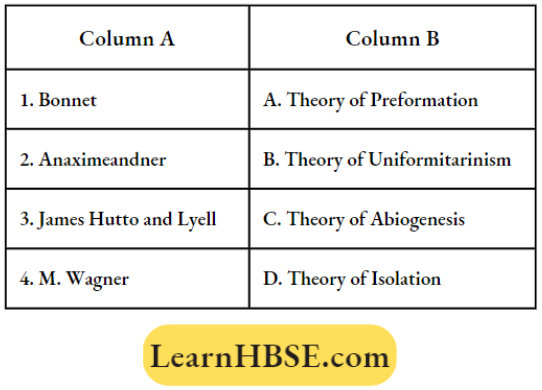
- 1→2→3→4
- 1→3→2→4
- 4→3→2→1
- 3→2→1→4
Answer: 2. 1→3→2→4
Question 87. An evolutionary trend in which there is a general degeneration and loss of organs is:
- Retrogressive
- Progressive
- Vestigial
- Stasignesis
Answer: 1. Retrogressive
Question 88. As per geological time scale, hominids evolved during:
- Miocene
- Oligocene
- Pliocene
- Pleistocene.
Answer: 3. Pliocene
Question 89. From which of the following did the modern horse called Equus arise in the early Cenozoic era?
- Pliohippus
- Merychippus
- Orohippus
- Eohippus.
Answer: 4. Eohippus.
Question 90. Analogous organs with similar external morphology are called:
- Homoplastic
- Heteroplastic
- Heteromorphic
- Both 2 and 3.
Answer: 1. Homoplastic
Question 91. Stings develop from:
- Last abdominal segment in honey bee and scorpion
- Ovipositor in honey bees and scorpions
- Last abdominal segment in honey bee and ovipositor in scorpion
- Ovipositor in honey bee and last abdominal segment in scorpion.
Answer: 4. Ovipositor in honey bee and last abdominal segment in scorpion.
Question 92. In human beings, canine teeth are:
- Useless
- Required for tearing food parts
- Chewing teeth
- Used for nibbling food articles.
Answer: 2. Required for tearing food parts

